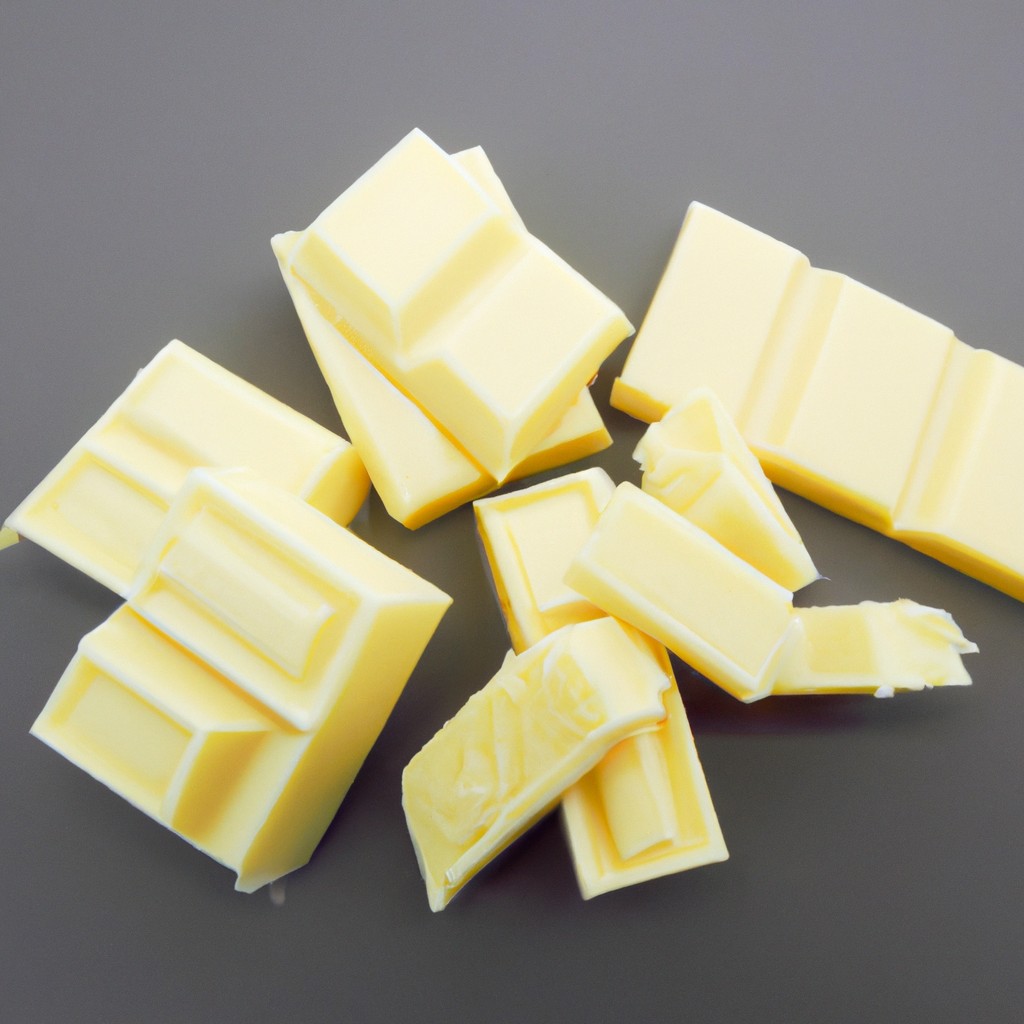White chocolate, often misunderstood and underrated, is primarily made of cocoa butter, milk solids, and sugar; this article sheds light on its composition and creation process.
Key takeaways:
- White chocolate is made of cocoa butter, milk solids, and sugar.
- Unlike dark chocolate, white chocolate does not contain cocoa solids.
- Dark chocolate has a stronger cocoa flavor, while white chocolate is sweeter.
- The process of making white chocolate involves separating cocoa beans, blending with other ingredients, and tempering.
- White chocolate is used in various culinary applications, including desserts and beverages.
Inside
White Chocolate Ingredients

White chocolate’s unique character comes from a blend of cocoa butter, sugar, and milk solids. Cocoa butter provides the smooth, creamy foundation that sets white chocolate apart from its milk and dark counterparts. The sugar sweetens the mix, while milk solids give white chocolate its velvety richness and pale color.
Unlike dark and milk chocolates, white chocolate doesn’t contain cocoa solids, the component responsible for the characteristic chocolate flavor and darker hue. Emulsifiers, such as soy lecithin, are often added to enhance texture and fluidity, and vanilla is frequently infused for a subtle depth of flavor. The balance and quality of these ingredients play a crucial role in the final taste and mouthfeel of the white chocolate.
White Chocolate Versus Dark Chocolate
Understanding the fundamental differences between white and dark chocolate is crucial in appreciating their unique characteristics. While both hail from the cacao tree, the composition and processing of the beans set these confections apart.
The primary ingredient in dark chocolate is cocoa solids, contributing to its characteristic taste and color. These solids contain antioxidants known as flavonoids, which are absent in white chocolate due to the lack of cocoa solids. Instead, white chocolate contains cocoa butter, which gives it a creamier texture and a pale ivory color.
Dark chocolate boasts a robust, sometimes bitter flavor profile, while white chocolate offers a sweeter, more delicate taste. Sugar content in white chocolate is higher, accounting for its richer sweetness compared to dark chocolate’s reduced sugar levels and more pronounced cocoa flavor.
Moreover, dark chocolate often includes cocoa liquor and a varying percentage of cocoa ranging from 30% to upwards of 80% or more, introducing a spectrum of intensity. White chocolate lacks this variety, as it does not contain cocoa liquor, and its cocoa butter content is generally consistent across different brands.
Lastly, dark chocolate contains minimal milk solids, if any, aligning with the preferences of those who seek a more vegan-friendly option. Meanwhile, milk solids and milk fat are notable components in white chocolate, enriching its creamy profile while also necessitating consideration for those with dairy sensitivities or dietary restrictions.
How White Chocolate Is Made: A Step-By-Step Guide
The manufacturing of white chocolate begins with the separation of cocoa beans into cocoa solids and cocoa butter. Here’s the process broken down:
- Cocoa beans are harvested, fermented, and dried.
- The beans are then roasted to develop flavor profiles.
- Roasted beans are shelled to extract nibs, which are then ground into a paste.
- Through pressing, the cocoa paste releases cocoa butter while retaining cocoa solids—white chocolate uses only the butter.
- The cocoa butter is blended with sugar, milk powder, and often vanilla for flavor.
- This mixture undergoes a process called conching, where it’s smoothed out to a fine texture.
- Emulsifiers such as lecithin may be added to improve consistency.
- The refined white chocolate is tempered, which involves carefully heating and cooling to form stable cocoa butter crystals.
- Once tempered, the chocolate is molded into bars or shapes and allowed to cool and solidify.
Common Uses For White Chocolate
White chocolate’s creamy texture and sweet profile make it a favorite ingredient in a variety of culinary applications. It’s often used to craft luscious ganaches that serve as fillings for truffles and bonbons, elevating the confectionery experience. Bakers also melt it down to drizzle over pastries or incorporate into frosting, adding a decorative touch and a hint of velvety sweetness to cakes and cupcakes.
Beyond desserts, white chocolate can be found in beverages, where it adds a rich, comforting flavor to hot chocolate and coffee drinks. Its delicate presence is also used to balance the flavors in certain savory dishes, such as sauces and glazes for meats, where it can impart a subtle sweetness and depth.
In chocolate work, it’s valued for its color and smoothness, often being used to create contrasting designs in chocolate bars and intricate decorations on confections. Additionally, due to its milky composition, it’s a popular choice for chocolate sculptures and modeling, as it sets without darkening, maintaining its pristine appearance.
Is White Chocolate Chocolate?
The debate surrounding white chocolate’s status as “real” chocolate stems from its composition. Unlike milk and dark chocolate, it lacks cocoa solids—the primary aromatic ingredient. The absence of these solids, which give chocolate its characteristic flavor and color, leads some purists to argue that white chocolate falls outside the traditional chocolate category.
However, white chocolate qualifies as chocolate under certain regulations. For instance, in the United States, the FDA mandates that white chocolate must contain at least 20% cocoa butter, 14% milk solids, and 3.5% milkfat. The presence of cocoa butter, derived from the cocoa bean, solidifies its inclusion in the chocolate family, albeit as a distinct variation.
The absence of cocoa solids in white chocolate provides it with a smoother, creamier texture and a sweeter taste, which complements flavors like vanilla and other added ingredients, distinguishing its culinary applications from those of milk or dark chocolate.




